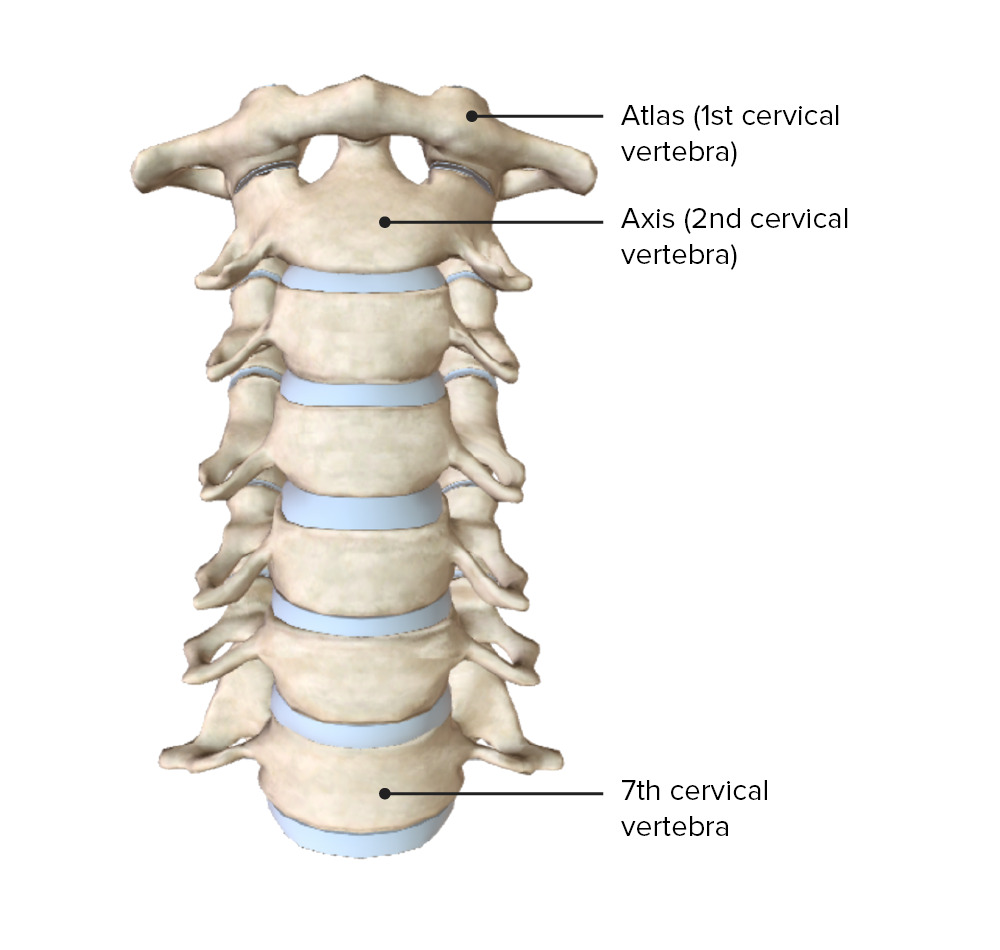Playlist
Show Playlist
Hide Playlist
Foramina of the Vertebral Column
-
Slides Anatomy Foramina of the Vertebral Column.pdf
-
Download Lecture Overview
00:01 Now let's take a look at some of the holes or foramina found in the vertebral column. 00:08 We'll start with a superior view where we can see the body sitting anteriorly. 00:13 And just posterior to that, we have the vertebral foramen. 00:19 And on either side of the vertebral foramen, we have the pedicles that attach the body to the vertebral arch. 00:26 And then more posteriorly we have the lamina that connect the vertebral arch to the spinous process. 00:33 Within the vertebral foramen is where we find the spinal cord. 00:38 And at each level, the spinal cord is going to give off anterior and posterior roots that are going to fuse to form a spinal nerve that exits at each level of the vertebral column. 00:50 Let's look at two adjacent vertebra and how they come together. 00:55 There's an inferior vertebral notch on the vertebra above and a superior notch on the vertebra below. 01:05 And when we put these together, we see that there's another foramen this one we call the intervertebral foramen. 01:12 Bounded anteriorly by the body and disc and posteriorly by the facets or the zygapophyseal joints. 01:22 This is where we're going to find the exit root for those spinal nerves. 01:28 So again, we have a body, an intervertebral disc connecting it to an adjacent body. 01:34 And then posterior we have the spinous process laterally we have the transverse process. 01:41 If we zoom in, we can see the spinal ganglion and nerve exiting at this level through the intervertebral foramen. 01:49 And then when we look into the vertebral foramen, the first thing we would see working from superficial to deep is a space outside of the dura therefore we call it the extradural space. 02:01 It's usually filled with extradural fat. 02:06 Then we hit the first layer of meninges which are the coverings for both the brain and the spinal cord. 02:11 The outer one being the toughest one is the dura mater. 02:15 Dura meaning hard like durable is something that's very hard. 02:19 Deep to that as the arachnoid layer and in between we have the subdural space. 02:27 The next layer down is the pia mater and between the arachnoid and pia is the subarachnoid space. 02:34 In the pia mater is attached directly to the surface of the spinal cord and cannot be easily separated from it. 02:43 Let's look at a sagittal cross section now of a vertebral column with the spinal cord in place. 02:49 So here we see some vertebra in the spinal cord which actually ends as a cord roughly around the L1 L2 vertebra area. 03:00 After that point, it becomes just a series of spinal nerves called the cauda equina or horse's tail. 03:07 in something called spinal bifida, the fusion of the posterior aspects of the vertebral column is incomplete. 03:15 And sometimes when that happens, you can have a protrusion of these contents something called a myelomeningocele. 03:24 And this results from problems with neural tube formation. 03:29 And it has to do with how the neural tube or the central nervous system forms. 03:34 Very early in development we have an outer layer called the ectoderm which will eventually form the epidermis. 03:40 But in the midline of what will become the back is something called the neural plate that gets pulled down to form a groove that should usually seal off to form a complete neural tube. 03:53 When cases of closure are incomplete, we have neural tube defects. 04:01 And neural tube defects can affect anything from the brain through the course of the spinal cord, with spina bifida being just one of the possible outcomes.
About the Lecture
The lecture Foramina of the Vertebral Column by Darren Salmi, MD, MS is from the course Back Anatomy.
Included Quiz Questions
What is the most superficial membrane or structure within the spinal canal?
- Extradural fat
- Pia
- Arachnoid
- Dura
- Spinal cord
What is a protrusion of the meninges through a gap in the spine?
- Meningocele
- Myelocele
- Neural fold
- Meningeal hernia
- Neural groove
Customer reviews
5,0 of 5 stars
| 5 Stars |
|
5 |
| 4 Stars |
|
0 |
| 3 Stars |
|
0 |
| 2 Stars |
|
0 |
| 1 Star |
|
0 |




